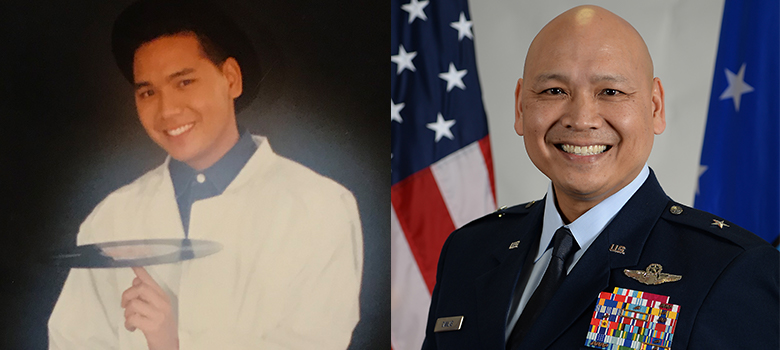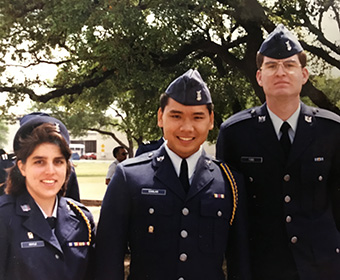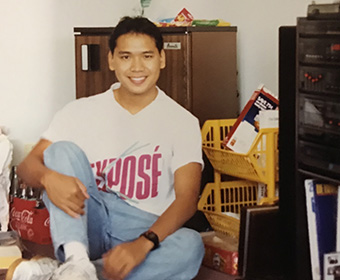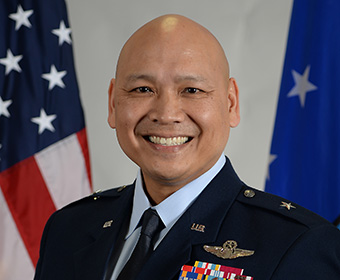
(March 12, 2019) -- Many of us hold an entertainment-induced stereotype of Brigadier Generals, believing them to be gruff, stern, loud and always angry. UTSA electrical engineering graduate Jimmy Canlas ’92 breaks that stereotype with his huge smile, humble spirit and love of enjoyment. He currently serves as the Commander of the 618th Air Operations Center at Scott Air Force Base, Ill., where troops provide command and control of air mobility forces around the world. His unit(s) oversee nearly 1,100 aircraft.
Canlas began his military career in UTSA’s Air Force ROTC. At the same time, he chose to enjoy his college time as a disc jockey at the Roost, and as one of the first residents of Chisholm Hall when it opened in 1987. He was commissioned in 1992 as a distinguished graduate from UTSA AFROTC program and earned his pilot wings in 1994. Prior to his current assignment, he served as Commander of the 437th Air Lift Wing at Joint Base Charleston, SC.
UTSA Today met up with Brigadier General Canlas, who shared how his UTSA journey equipped him to be the leader he is today. We will begin with his life as a Roadrunner on campus and share the lessons learned.

The UTSA Air Force ROTC played an integral role in Canlas' time at UTSA.
How did you select UTSA to be your undergraduate school?
I graduated from high school overseas in the Philippines. I knew I wanted to join the Air Force and fly airplanes, and I sought that path through Air Force ROTC. I applied to several colleges with AFROTC programs and was accepted to Washington University, Cal State and UTSA. I chose UTSA based on location to be close to family, since I had a brother in the Air Force stationed at Lackland Air Force Base at that time.
Why did you desire military service?
My grandfather served in the U.S. Army during World War II in the Pacific. He was one of General Douglas MacArthur’s drivers and was also a survivor of the Bataan Death March. My father served in the U.S. Navy and served two tours in Vietnam. Military service was in my DNA, and I always felt compelled to serve our great nation.
How did you select electrical engineering (EE) for a major?
My father was an electrician in the Navy, and he taught me a lot of electrical basics as a kid. That spurred my fascination with all things electrical—motors, circuits, production. Additionally, I was fairly good at math and physics, so EE seemed like a good fit.
Is there one story from your time at UTSA that will always be with you?
Perhaps one of my favorite memories was spinning records under the Sombrilla for Fiesta. The university hired me to play music for a couple of hours, and the crowd simply could not get enough, dancing until we had to cut the music off. It was just good, clean fun.
>> Learn more about Canlas and other Roadrunners You Should Know.
You also spun records as a disc jockey at the Roost on Thursday nights. What music was most popular with UTSA students at that time?
I believe my popularity as a DJ came from my ability to read the crowds and appeal to them through multiple genres of music. My bread and butter were 80s hip-hop and new wave music, but I would also play country. Songs like “It Takes Two” by Rob Base, “Bizarre Love Triangle” by New Order, underground classic “American-Soviets” by CCCP, “What I Like About You” by the Romantics and “Friends in Low Places” by Garth Brooks were all sure-fire hits to get folks on the dance floor. These songs would probably still make a splash today, albeit with an older crowd!

Canlas in his room at Chisholm Hall.
What is something about your time at UTSA you have never shared with anyone until this moment?
One of the favorite things we loved to do was explore the campus in the middle of the night—long after the students and cleaning crews had left. Back in the late 80s, UTSA was primarily a commuter school with the exception of the few hundred that lived in Chisholm Hall. It was not uncommon for us to roam around at midnight, taking pictures, enjoying the cool Texas evenings and looking at the stars.
You struggled with some of your classes while you were an undergrad. How did you go from a struggling student to a successful military career? Can you share the important lessons you learned?
I struggled a lot with my digital circuits and computer programming courses. My strength came on the analog side, and I was slow to adapt and embrace digital principles. It sounds silly now, but in the late 80s, the struggle was real for me!
I learned several things from this. First, don’t be too proud to ask for help. I refused to go to a tutor thinking I can climb out of this hole on my own. I was wrong. Second, growth comes from being outside your comfort zone. I didn’t realize how much I learned until after all the pain of taking classes I necessarily didn’t enjoy. Learning the digital side of the house is paying dividends until this day.
My time at UTSA taught me perseverance. I struggled with a few classes but through the help of some caring professors, they helped get me through. I learned to never give up, to keep an eye on the bigger prize, having faith the hard work would eventually pay off. Additionally, the AFROTC detachment was world-class at UTSA and prepared me well for my Air Force journey.

How do you plan to be known and respected as a great leader? What leadership qualities are most important to you?
I am a strong believer in servant leadership. I always say that although I have people assigned under me, I am their servant. My job is to make their life better and to remove any obstacles that may be inhibiting them from reaching their full potential. My hope is others feel the impact through my actions, and that they follow suit to serve the same way.
What do you want to share with students considering military service?
The Air Force has been a huge, fun adventure that has been both personally and professionally rewarding. As a young officer, I was able to fly airplanes around the world, and get paid to do it! Post 9/11, I was afforded the opportunity to lead Airmen into combat zones as we sought out to destroy terrorist networks. Later, I was given the privilege of command, where I was responsible for the welfare of the Airmen assigned to me.
Each day, I have the honor of serving side by side some of the finest citizens our country has to offer—people who are willing to pay the ultimate sacrifice in the name of freedom. This creates camaraderie and a sense of teamwork found nowhere else. If you love our country and want to be a part of something bigger than yourself, come join us!
Celebrate UTSA’s 50th Anniversary and share social media posts about the 50th using the hashtag #UTSA50.
Connect with UTSA online at Facebook, Twitter, YouTube, Instagram and LinkedIn.
UTSA Today is produced by University Communications and Marketing, the official news source of The University of Texas at San Antonio. Send your feedback to news@utsa.edu. Keep up-to-date on UTSA news by visiting UTSA Today. Connect with UTSA online at Facebook, Twitter, Youtube and Instagram.
Move-in Day is an exciting time for incoming students. Students living in Laurel Village move in on August 22. The UTSA Housing and Residence Life (HRL) team looks forward to welcoming you all and helping you settle into your room.
Laurel VillageThe College of Sciences welcomes our newest Roadrunners to UTSA at VIVA Science! This interactive event connects students with faculty, staff, student leaders, and peers while highlighting the opportunities available across the College.
Outdoor Learning Environment 2 (OLE), Flawn Building, Main CampusWe're excited to welcome the new class of UTSA College of Liberal and Fine Arts (COLFA) students to campus! Move In To COLFA is strongly recommended for new students in COLFA because it gives you the chance to learn about the Student Success Center, learn how to do college successfully and meet new friends.
Galleria (MH 2.01), McKinney Humanities Building, Main CampusBuild connections with your Alvarez College of Business peers and learn more about the Career Compass program! This opportunity will provide fun interactions, giveaways and a chance to meet your next friend!
Richard Liu Auditorium (BB 2.01.02,) Business Building, Main CampusCelebrate the end of summer and the start off a great fall semester with The Housing Block Party! This event will have live music, carnival-style treats, artists, games, and activities galore. Come and join us for a night of fun!
Multipurpose Room/Lawn, Guadalupe Hall, Main CampusBe part of an unforgettable night as SOSA takes the field for its first public performance of the season! Experience the power, pride, and pageantry of UTSA’s marching band. Learn beloved traditions, practice cheers, and feel what it means to be a Roadrunner.
Campus Rec FieldsAfter getting your student settled in their room, connect with other UTSA families at our Family Get Together. Attendees need to RSVP for the event.
Rock & Brews Restaurant - 5702 Landmark Pkwy, San Antonio, TX 78249The University of Texas at San Antonio is dedicated to the advancement of knowledge through research and discovery, teaching and learning, community engagement and public service. As an institution of access and excellence, UTSA embraces multicultural traditions and serves as a center for intellectual and creative resources as well as a catalyst for socioeconomic development and the commercialization of intellectual property - for Texas, the nation and the world.
To be a premier public research university, providing access to educational excellence and preparing citizen leaders for the global environment.
We encourage an environment of dialogue and discovery, where integrity, excellence, respect, collaboration and innovation are fostered.